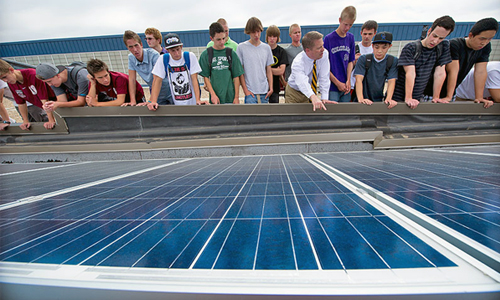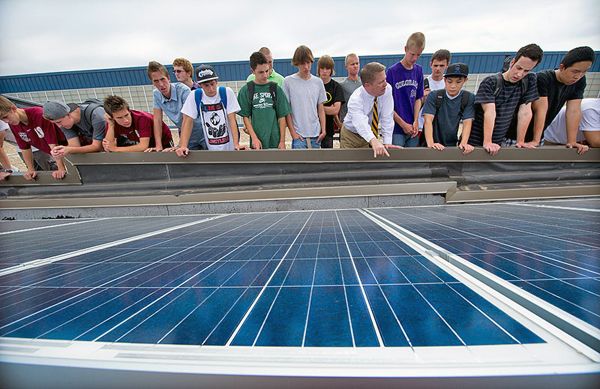
Parents, Teachers and Students Ask School Districts to Go 100% Renewable Energy

Now that solar is cheaper than electricity from the grid in 42 of 50 largest U.S. cities, it’s no wonder that a coalition of education, health, labor and environmental organizations launched a campaign to encourage North Carolina’s public school districts to transition to 100 percent renewable energy. Repower Our Schools was launched today calling for the Charlotte and Durham, North Carolina school boards to pass a resolution committing to run their schools on renewable energy this year.
According to a recent report from The Solar Foundation, school districts across the country could each save more than $1 million over 30 years by installing a solar system.
“As utility rates continue to rise across North Carolina, solar continues to get cheaper—providing an affordable alternative for the school districts,” said Greenpeace Charlotte field organizer Michael Zytkow. “Repowering Our Schools stands to save money that can be reinvested in the classroom. By making this commitment, school boards are committing not only to save precious funds, but also to protect our kids’ health, help save our environment and provide real-world learning experiences for students.”
Installing solar energy at schools, goes way beyond saving money, it also allows the schools to incorporate solar into the science, technology, engineering and mathematics (STEM) curriculum.
“The Repower Our Schools campaign is important to me because the money we could save on electricity by switching to solar power would go right back to our students—where it belongs,” said Durham Public Schools Teacher Dov Rosenberg. “Additionally, this provides a great opportunity to teach our students about the science behind energy production, the pollution caused by coal-burning power plants, including ash spills, and that they have the power to alter the course of our energy economy to a more sustainable future.”
The coalition also stresses the health benefits of going solar. They report that more than 50,000 students across the North Carolina suffer from asthma, making it the leading cause of missed school for children with chronic diseases.
“The burning of fossil fuels contributes to air pollution in our state, producing toxins that increase the incidence and severity of asthma and other lung diseases in children,” said Medical Advocates for Healthy Air manager Terry Lansdell. “A transition to renewable energy will directly impact each student’s health. Powering our schools with solar will help lower health related absences, reduce the burden of on-site health care professionals, and allow for a healthy outdoor environment that promotes pollution-free physical activity before, during and after school hours.”
The Repower Our Schools coalition includes the Charlotte branch of the National Association for the Advancement of Colored People, Alliance for Climate Education, Medical Advocates for Healthy Air, Action NC, Greenpeace, Sierra Club, Moms Clean Air Force and more than a dozen other partners.
“As a mom who is concerned about the health of my child and her future, I am thrilled about this opportunity for schools to go solar and cut down on the pollution that is damaging our region’s air,” said Moms Clean Air Force organizer Danielle Hilton. “I hope the school boards pass resolutions to help make this happen as soon as possible.”
YOU MIGHT ALSO LIKE
Solar Is Cheaper Than Electricity From the Grid in 42 of 50 Largest U.S. Cities

 233k
233k  41k
41k  Subscribe
Subscribe 
